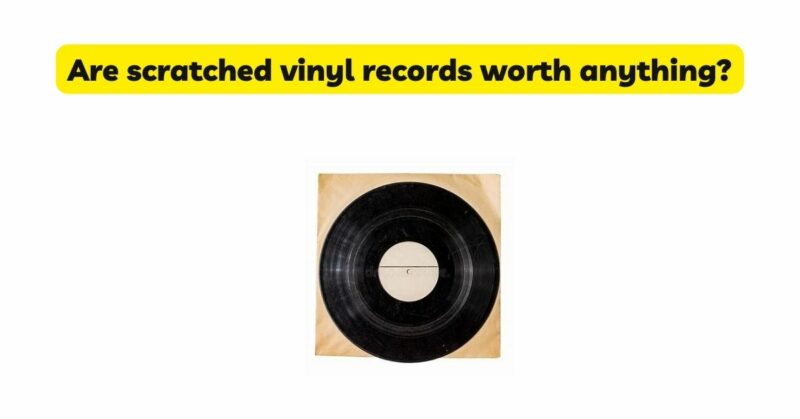Vinyl records possess a certain allure, with their warm sound and tangible presence. However, scratches on vinyl records can significantly impact their playability and raise questions about their value. In this article, we delve into the world of scratched vinyl records, exploring their potential worth, restoration possibilities, and the market factors that affect their value. By understanding the intricacies of scratched records, collectors and enthusiasts can make informed decisions regarding their damaged vinyl and explore the possibilities of preserving their musical treasures.
I. The Significance of Vinyl Records
Vinyl records hold a special place in the hearts of music enthusiasts. Their tangible nature, album artwork, and superior audio quality make them coveted items for collectors and audiophiles alike. Owning a vinyl record allows one to experience music in a unique way, with its distinctive sound and nostalgic charm.
II. Scratched Vinyl Records: Evaluating Worth
Scratches on vinyl records can significantly impact their value, but determining the worth of a scratched record depends on various factors:
- Rarity and Collectibility: Some records, even if scratched, may still hold value due to their rarity or collectibility. Limited editions, first pressings, or albums from iconic artists can have significant worth to collectors, even with surface damage.
- Severity of Scratches: The extent and severity of scratches play a crucial role in determining a record’s value. Superficial, light scratches that do not affect playability may have minimal impact on worth, while deep or multiple scratches that cause skips or distortions can diminish a record’s value.
- Demand and Scarcity: The demand for specific albums or genres can influence the market value of scratched records. Scarce or sought-after records may still have value, even with scratches, if there is a strong demand among collectors.
- Historical Significance: Some scratched records hold historical significance, such as early pressings or albums associated with notable events or artists. The historical value can outweigh the surface damage, making these records desirable to collectors.
III. Restoration Possibilities
While scratches on vinyl records cannot be completely eliminated, there are restoration techniques that can improve playability and minimize surface noise:
- Cleaning and Dust Removal: Thoroughly cleaning a record using specialized solutions and brushes can help reduce surface noise caused by dust particles. However, this method is not effective for deep scratches.
- Wet Cleaning and Vacuuming: Wet cleaning involves using a liquid solution and a record-cleaning machine to remove dirt and debris from the grooves. Vacuuming machines can extract the cleaning fluid and contaminants, enhancing the record’s sound quality. While this method may improve the overall playback, it cannot repair deep scratches.
- Groove Fillers and Polishing: For shallower scratches, groove fillers and polishing compounds can be used to fill in the damaged areas and create a smoother surface. This method can reduce the audible effects of scratches, but it is not a permanent solution.
- Professional Restoration Services: In cases where valuable or historically significant records are scratched, professional restoration services can be employed. These specialists use advanced techniques and equipment to restore records to the best possible condition, minimizing surface noise and optimizing playability. However, the cost of professional restoration should be weighed against the value of the record.
IV. Market Considerations
Understanding the market for scratched vinyl records is essential for gauging their value:
- Condition Grading: The condition of a scratched record is crucial when determining its value in the market. Record collectors often follow established grading systems, such as the Goldmine Standard, which assesses the overall condition of the record, cover, and inserts. Scratched records may be assigned a lower grade, affecting their market value.
- Collector Demand: The demand for scratched records can vary depending on the collector’s preferences and interests. Some collectors prioritize rare records despite scratches, while others may focus on obtaining pristine copies. Researching collector communities, online marketplaces, and record fairs can provide insights into the demand for scratched records.
- Price Adjustments: When selling scratched records, sellers may adjust the price to reflect the condition. The market value of a scratched record will likely be lower compared to a pristine copy of the same release. Pricing should be reasonable and take into account the specific condition of the record.
- Emotional Value: In some cases, scratched records may hold sentimental or personal value to their owners, irrespective of their market worth. The emotional connection one has with a particular album or the memories associated with a scratched record can outweigh its monetary value.
Conclusion
Scratched vinyl records can still hold value, albeit with considerations regarding their rarity, severity of scratches, demand, and market factors. While complete restoration of scratched records is not always possible, various techniques can improve playability and reduce surface noise. Professional restoration services may be worth considering for valuable or historically significant records. The market for scratched records is influenced by collector demand and grading systems, with price adjustments reflecting the condition of the record. It’s important to remember that scratched records may still hold emotional or sentimental value beyond their market worth, making them cherished possessions for their owners. Ultimately, the value of a scratched vinyl record lies in the eye of the collector, who can appreciate the music and the unique character that each record brings, regardless of its imperfections.


